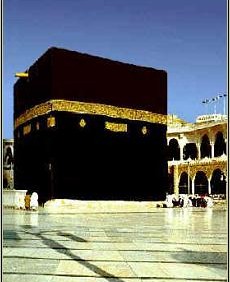|
The Ka'ba An good example of sacred space in Islam is that of the Ka’ba – the House of Allah, in Mecca. |
|
| In Islam the Ka'ba is considered one of the most sacred sites. The ka'ba itself is a cubicle structure that is situated in the city of Mecca. As a matter of fact, the word Ka'ba means "cube" in Arabic. A black stone, perhaps from a meteor, is embedded in one of the walls of the Ka'ba. The black stone is believed to have fallen from heaven as a sign of God's covenant with Abraham and Ishmael. According to the Qu'ran the Ka'ba was built by Abraham and Ishmael in obedience to God as a place of worship of the one true God. Over time, however, the ka'ba came to house many idols that pilgrims worshipped. |
|
| When Muhammad entered Mecca in triumph in 630 CE he destroyed the idols in the ka'ba. Moreover, it was revealed to Muhammad that his followers should face the Ka'ba in Mecca whenever - and wherever - they pray. When pilgrims go to Mecca they walk around the Ka'ba seven times and try to touch or kiss the black stone embedded in its wall. This is based on the tradition that Abraham would walk around the ka'ba and touch the stone. The prophet Muhammad did so as well. This circumambulation (walking around) is typical of many religious traditions (a similar act takes place at the Christian sacred site of Lourdes), and demonstrates how the cosmos turns around this axis mundi. | |
| The sacredness of the ka'ba is not due to the presence of God. Indeed, Muslims would strongly reject the notion that God's presence could be contained in any object. Nevertheless, the ka'ba is a focal point of the encounter with the sacred experienced by Abraham. | |
| Other sacred places include Mount Zion (Judaism), Lourdes (Christianity), Calvary (Christianity), Mount Fuji (Shinto). Man-made structures such as the gothic cathedral, the Hindu temple and the Buddhist stupa also function as sacred space insofar as they mirror sacred reality and provide a point of orientation around which the world can be organized. The stupa was originally a monument that held the remains of an important person. Buddhism transformed the stupa into a sacred space that re-presents the cosmos and orients one to the basic worldview and teachings of Buddhism. | |
|
For an online investigation of sacred space visit the Sacred Places Web site at http://witcombe.sbc.edu/sacredplaces/sacredplacesintro.html
|
|
